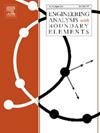生物启发螺旋形旋转层压复合板在热条件下的自由振动行为:多输出机器学习方法
IF 4.2
2区 工程技术
Q1 ENGINEERING, MULTIDISCIPLINARY
Engineering Analysis with Boundary Elements
Pub Date : 2024-11-06
DOI:10.1016/j.enganabound.2024.106024
引用次数: 0
摘要
本研究旨在利用在热条件下抛物线剪切变形理论底盘训练的单输出支持向量机(SVM)算法,研究生物启发螺旋形层压复合材料球形、环形和锥形壳体面板的自由振动行为。采用了不同的螺旋形层压方案,如斐波那契、半圆、指数、递归和线性螺旋形方案。采用了与温度相关的材料特性。研究了壳体的几何形状、温度和层压方案对球形、环形和锥形壳体面板自由振动行为的影响。此外,还使用不同的多输出 SVM 代理获得了模态振型,其中在不同位置获得了位移,并通过预测获得了基本模态振型。与抛物线剪切变形理论相比,训练有素的代用模型能更快地预测基频值和模态振型。本文章由计算机程序翻译,如有差异,请以英文原文为准。
Free vibration behaviour of bio-inspired helicoidal laminated composite panels of revolution under thermal conditions: Multi-output machine learning approach
The present work aims to study the free vibration behaviour of bio-inspired helicoidal laminated composite spherical, toroid, and conical shell panels using a single-output Support Vector Machine (SVM) algorithm trained in the chassis of parabolic shear deformation theory under thermal conditions. Different helicoidal lamination schemes are adopted, such as Fibonacci, semi-circular, exponential, recursive, and linear helicoidal schemes. Temperature-dependent material properties are adopted. The effect of the geometry of the shell, temperature, and lamination scheme on the free vibration behaviour of spherical, toroid, and conical shell panels is studied. Also, the mode shapes are obtained using different multi-output SVM surrogate in which the displacements are obtained at different locations and are predicted to obtain the fundamental mode shape. The trained surrogate model can predict the values of fundamental frequency and mode shapes much faster than the parabolic shear deformation theory.
求助全文
通过发布文献求助,成功后即可免费获取论文全文。
去求助
来源期刊

Engineering Analysis with Boundary Elements
工程技术-工程:综合
CiteScore
5.50
自引率
18.20%
发文量
368
审稿时长
56 days
期刊介绍:
This journal is specifically dedicated to the dissemination of the latest developments of new engineering analysis techniques using boundary elements and other mesh reduction methods.
Boundary element (BEM) and mesh reduction methods (MRM) are very active areas of research with the techniques being applied to solve increasingly complex problems. The journal stresses the importance of these applications as well as their computational aspects, reliability and robustness.
The main criteria for publication will be the originality of the work being reported, its potential usefulness and applications of the methods to new fields.
In addition to regular issues, the journal publishes a series of special issues dealing with specific areas of current research.
The journal has, for many years, provided a channel of communication between academics and industrial researchers working in mesh reduction methods
Fields Covered:
• Boundary Element Methods (BEM)
• Mesh Reduction Methods (MRM)
• Meshless Methods
• Integral Equations
• Applications of BEM/MRM in Engineering
• Numerical Methods related to BEM/MRM
• Computational Techniques
• Combination of Different Methods
• Advanced Formulations.
 求助内容:
求助内容: 应助结果提醒方式:
应助结果提醒方式:


